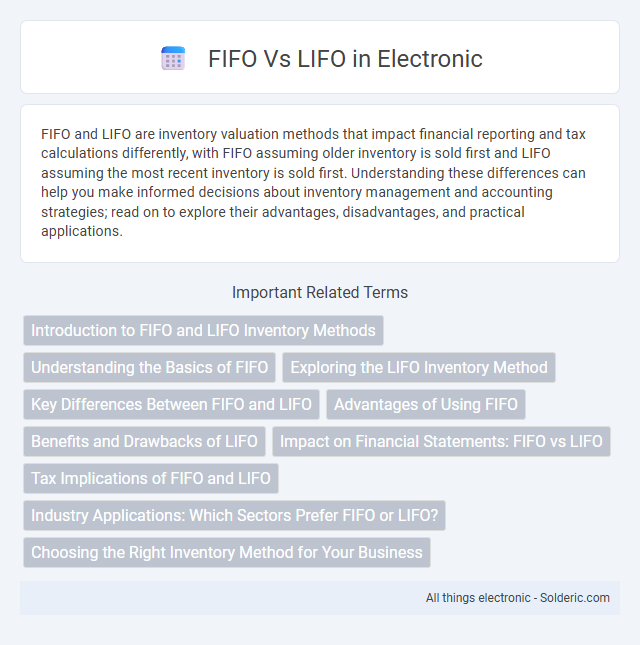FIFO and LIFO are inventory valuation methods that impact financial reporting and tax calculations differently, with FIFO assuming older inventory is sold first and LIFO assuming the most recent inventory is sold first. Understanding these differences can help you make informed decisions about inventory management and accounting strategies; read on to explore their advantages, disadvantages, and practical applications.
Comparison Table
| Aspect | FIFO (First In, First Out) | LIFO (Last In, First Out) |
|---|---|---|
| Definition | Inventory accounting method where the oldest items are sold first. | Inventory accounting method where the newest items are sold first. |
| Cost Flow | Costs of oldest inventory recorded first. | Costs of newest inventory recorded first. |
| Impact on Financial Statements | Higher net income during inflation; ending inventory valued at recent costs. | Lower net income during inflation; ending inventory valued at older costs. |
| Tax Implications | Typically higher taxes due to higher profits. | Can reduce tax liability by reporting lower profits. |
| Inventory Valuation | Reflects more accurate current market value. | May undervalue ending inventory during inflation. |
| Usage | Commonly used globally; GAAP and IFRS compliant. | Permitted under GAAP; prohibited under IFRS. |
Introduction to FIFO and LIFO Inventory Methods
FIFO (First-In, First-Out) and LIFO (Last-In, First-Out) are fundamental inventory valuation methods used in accounting and supply chain management. FIFO assumes that the oldest inventory items are sold first, reflecting current market costs in ending inventory, whereas LIFO assumes the most recently acquired items are sold first, often matching current costs with revenues. These methods impact financial statements, tax calculations, and inventory management strategies by influencing cost of goods sold (COGS) and inventory valuation during periods of price fluctuations.
Understanding the Basics of FIFO
FIFO (First In, First Out) is an inventory valuation method where the oldest stock is used or sold first, ensuring accurate matching of costs with current revenues. This approach helps maintain consistent inventory turnover and reflects realistic profit margins, especially in times of inflation. Your financial reports will benefit from FIFO by presenting inventory at recent purchase costs, enhancing clarity for stakeholders.
Exploring the LIFO Inventory Method
The LIFO (Last-In, First-Out) inventory method records the newest inventory items as sold first, which can lead to higher cost of goods sold and lower taxable income during inflationary periods. Companies using LIFO often benefit from tax advantages by matching recent higher costs against current revenues, although it may result in outdated inventory values on the balance sheet. This method contrasts with FIFO, which assumes older inventory is sold first, affecting financial statements and tax liabilities differently.
Key Differences Between FIFO and LIFO
FIFO (First In, First Out) and LIFO (Last In, First Out) differ primarily in inventory valuation and cost flow assumptions. FIFO assumes the oldest inventory items are sold first, often resulting in lower cost of goods sold and higher ending inventory during inflation, while LIFO assumes the newest items are sold first, leading to higher cost of goods sold and lower taxable income. Your choice between FIFO and LIFO impacts financial statements, tax liabilities, and inventory management strategies.
Advantages of Using FIFO
FIFO ensures that inventory is valued at the most recent costs, providing a more accurate reflection of current market prices and financial health. This method reduces the risk of inventory obsolescence by selling older stock first, which is particularly beneficial for perishable goods. Your financial statements benefit from increased transparency and easier compliance with accounting standards due to the straightforward flow of costs under FIFO.
Benefits and Drawbacks of LIFO
LIFO (Last In, First Out) offers tax advantages during inflation by matching recent higher costs against current revenues, reducing taxable income. However, it may lead to outdated inventory values on the balance sheet, distorting financial analysis and potentially misleading stakeholders. LIFO's complexity in implementation and reporting can also result in increased administrative costs and regulatory scrutiny.
Impact on Financial Statements: FIFO vs LIFO
FIFO (First In, First Out) typically results in higher ending inventory values and lower cost of goods sold (COGS) during periods of rising prices, leading to higher reported net income and asset values on the balance sheet. LIFO (Last In, First Out) produces lower ending inventory and higher COGS under inflationary conditions, reducing taxable income but also decreasing reported profits and inventory values. The choice between FIFO and LIFO significantly affects gross margin, net income, and tax liabilities, influencing financial statement analysis and decision-making.
Tax Implications of FIFO and LIFO
FIFO (First In, First Out) typically results in higher taxable income during inflationary periods because older, lower-cost inventory is expensed first, increasing reported profits. LIFO (Last In, First Out) often reduces taxable income by matching recent higher inventory costs against revenues, lowering tax liability when prices rise. Your choice between FIFO and LIFO significantly influences tax payments and cash flow management strategies.
Industry Applications: Which Sectors Prefer FIFO or LIFO?
Manufacturing and retail sectors often prefer FIFO (First-In, First-Out) inventory accounting to match the flow of goods and reduce obsolescence risk, ensuring accurate cost tracking during inflation. LIFO (Last-In, First-Out) is commonly used in industries with significant inventory holding costs and fluctuating prices, such as oil, gas, and other raw material-intensive sectors, to minimize taxable income by matching recent higher costs against revenues. Your choice between FIFO and LIFO should align with industry-specific cost management and regulatory requirements.
Choosing the Right Inventory Method for Your Business
Selecting the appropriate inventory method, FIFO (First-In, First-Out) or LIFO (Last-In, First-Out), significantly impacts financial reporting and tax obligations. FIFO suits businesses with perishable goods or rising prices due to its reflection of current market costs, enhancing profit margins and inventory valuation accuracy. LIFO benefits companies facing inflation by matching recent higher costs against revenues, reducing taxable income but potentially understating inventory value on balance sheets.
FIFO vs LIFO Infographic

 solderic.com
solderic.com